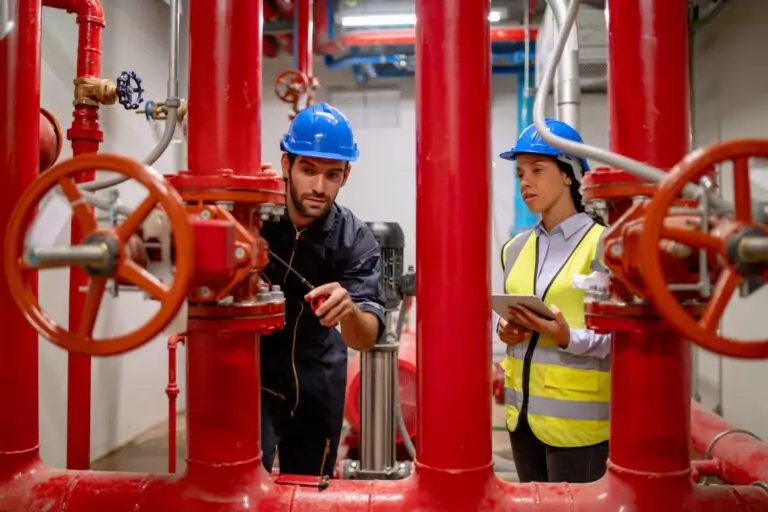Ever found yourself in the dark, quite literally, because of an unexpected power outage? It’s more than just an inconvenience; it can pose serious safety risks and lead to significant operational losses, especially in environments that depend on a stable factory distribution system.
Whether it’s for your home, business, or an entire industrial setup, keeping the electrical system in tip-top shape is non-negotiable for reliability and safety. But how do you go about this seemingly daunting task? Fear not!
We’re diving into the nuts and bolts of scheduling power maintenance – from assessing your system’s needs to executing a well-oiled maintenance plan. So, grab your notepad, and let’s shed some light on keeping the power flowing smoothly and safely.
What are the Steps to Schedule Power Maintenance?
Scheduling power maintenance is a critical task that ensures the reliability and safety of electrical systems, whether in industrial settings, commercial establishments, or residential areas. The process involves a series of steps designed to minimise disruptions, maintain efficiency, and ensure safety.
By following these steps, individuals and organisations can effectively schedule and carry out power maintenance, ensuring the reliability and safety of their electrical systems. This process not only helps prevent unexpected power outages but also extends the lifespan of electrical equipment, ultimately saving time and resources in the long run.
Assess the Power System’s Needs
The initial step in scheduling power maintenance involves a comprehensive assessment of the electrical system’s current condition. This crucial phase identifies any signs of wear and tear, potential hazards, or areas that may require upgrades or immediate attention. Implementing preventive checks for power distribution systems during this stage can significantly improve long-term system reliability and help avoid critical failures. By evaluating the system’s performance, energy efficiency, and safety standards, one can pinpoint specific maintenance needs.
This assessment forms the foundation for a tailored maintenance strategy, ensuring that all subsequent actions are informed and effective.
Plan the Maintenance Tasks
Following the assessment, the next step is to meticulously plan the maintenance tasks. This involves outlining a detailed maintenance schedule that specifies the scope of work, including which components need servicing, replacement, or upgrading. Planning also encompasses allocating the necessary resourcessuch as tools, equipment, and skilled personnel, required to execute the maintenance tasks.
A well-structured plan not only streamlines the maintenance process but also minimises the risk of overlooking critical issues, ensuring a thorough and efficient approach to system upkeep.
Determine the Maintenance Frequency
Determining the appropriate frequency for maintenance activities is pivotal. The maintenance frequency should be informed by the initial system assessment, taking into account the age of the system, its usage patterns, and any manufacturer recommendations for specific components. Regular, scheduled maintenance can prevent unexpected failures, extend the lifespan of the electrical system, and ensure its safe and reliable operation.
By establishing a routine maintenance schedule, stakeholders can anticipate and mitigate potential issues before they escalate, ensuring the system remains in optimal condition.
Why is Scheduling Power Maintenance Important?
Scheduling power maintenance is crucial for ensuring operational continuity, system reliability, and efficiency. Preventing unexpected outages, minimising disruptions to daily operations and avoiding the costs associated with downtime. Regular maintenance ensures that the electrical system operates at optimal efficiency, reducing energy consumption and costs.
In essence, scheduled power maintenance is a proactive measure that safeguards against potential failures, optimises performance and contributes to the overall sustainability of operations.
Prevents Unexpected Outages, Ensuring Operational Continuity
Scheduled power maintenance significantly reduces the risk of sudden electrical failures, thus ensuring that operations proceed without unexpected interruptions. This proactive approach is vital for maintaining the continuous flow of activities in any setting, be it industrial, commercial, or residential, safeguarding against the losses and inconveniences that unplanned outages can cause.
Ensures System Reliability and Efficiency
Regular maintenance checks and corrections keep the electrical system running at its best. By identifying and rectifying potential issues before they escalate, the system maintains a high level of reliability and efficiency. This not only ensures that energy is used optimally, leading to cost savings but also guarantees that the system can be relied upon to perform its functions when needed.
Extends Equipment Lifespan, Reducing Replacement Costs
Through the timely servicing and repair of electrical components, scheduled power maintenance extends the operational lifespan of the system’s equipment. This routine care prevents the premature wear and tear of components, delaying the need for costly replacements and thereby offering significant long-term financial benefits.
How to Assess the Power System’s Needs?
Assessing the power system’s needs involves reviewing historical maintenance records to identify recurring issues and trends. A detailed system performance analysis helps pinpoint inefficiencies and underperforming components. Identifying critical equipment that requires regular checks is essential for prioritising maintenance tasks.
This comprehensive assessment ensures maintenance efforts are focused and effective, optimising system performance and reliability.
Review Previous Maintenance Records for Trends and Issues
Analysing past maintenance logs provides insights into the system’s health over time, helping to spot patterns of wear or failure. This review aids in understanding which parts of the system are prone to issues, allowing for targeted preventive measures.
Conduct a System Performance Analysis to Identify Inefficiencies
Performing a thorough analysis of the system’s performance uncovers inefficiencies, such as energy wastage or overworked components. Recognising common signs of overload in distribution lines is a vital part of this analysis, helping to prevent severe malfunctions and ensure the system remains safe and efficient. This step is crucial for optimising the system’s operation and ensuring it runs at peak efficiency.
Identify Critical Components That Require Regular Checks
Determining which components are critical to the system’s operation guides the focus of maintenance efforts. Regular checks on these key parts prevent catastrophic failures and ensure the system’s reliability and safety.
How to Plan the Maintenance Tasks?
Planning maintenance tasks involves prioritising actions based on the system assessment and risk analysis, ensuring resources such as personnel and tools are adequately allocated. Clear objectives for each task must be set, detailing the expected outcomes to streamline the process and enhance efficiency. This strategic approach ensures that maintenance efforts are targeted, effective, and contribute to the system’s overall reliability and performance.
Prioritise Tasks Based on System Assessment and Risk Analysis
Prioritising tasks is crucial and should be based on a thorough assessment of the system’s current condition and a comprehensive risk analysis. This ensures that the most critical issues are addressed first, mitigating the risk of system failure and optimizing the use of available resources.
Allocate Resources, Including Personnel and Maintenance Tools
Allocating resources effectively is key to successful maintenance planning. This includes ensuring that skilled personnel are available and that the necessary maintenance tools and equipment are at hand. Proper allocation helps in the efficient execution of maintenance tasks, minimising downtime and ensuring safety.
Set Clear Objectives for Each Task, Outlining Expected Outcomes
Setting clear objectives for each maintenance task is essential. These objectives should detail the expected outcomes, providing a clear roadmap for the maintenance team. This clarity helps in focusing efforts, evaluating performance, and achieving the desired improvements in system reliability and efficiency.
How to Determine the Maintenance Frequency?
Determining the maintenance frequency is essential for optimising system performance and longevity. By establishing a tailored maintenance schedule, organisations can ensure their systems operate reliably and efficiently, minimising downtime and extending the life of their equipment.
Consider Manufacturer’s Recommendations for Each Equipment Type
Taking into account the manufacturer’s recommendations for each type of equipment is a fundamental step. These guidelines provide a baseline for the minimum maintenance frequency, ensuring that the equipment operates effectively and warranties remain valid.
Analyse System Usage Patterns to Predict Wear and Tear
Analysing system usage patterns is crucial for predicting potential wear and tear. Understanding how frequently and intensely the system is used helps in scheduling maintenance activities before issues arise, thereby preventing unexpected failures.
Adjust Based on Past Maintenance Outcomes and System Upgrades
Adjusting the maintenance schedule based on past outcomes and any system upgrades is vital for maintaining optimal performance. This adaptive approach allows for the fine-tuning of maintenance frequencies, ensuring that the system remains efficient and reliable over time.
What are the Best Practices for Scheduling Power Maintenance?
Best practices for scheduling power maintenance include early communication with all stakeholders, preparation for contingencies with backup power solutions, and thorough documentation and review of maintenance activities for continuous improvement. Utilising maintenance management software enhances scheduling and tracking while training personnel on new technologies and procedures ensures a skilled maintenance team. Regularly evaluating the impact of maintenance on system performance helps maintain system efficiency and reliability, aligning with the overarching goal of operational excellence.
Communicate Early with All Stakeholders, Including Affected Departments
Effective communication with all stakeholders, particularly affected departments, is crucial. This ensures everyone is informed about the maintenance schedule, minimising surprises and enabling preparations for downtime.
Prepare for Contingencies with Backup Power Solutions
Having backup power solutions in place is essential for mitigating the impact of maintenance-related downtimes. This preparation ensures operational continuity, safeguarding against potential disruptions.
Document and Review Maintenance Activities for Continuous Improvement
Documenting and reviewing all maintenance activities allows for continuous improvement. This practice helps identify successful strategies and areas needing adjustment, enhancing future maintenance planning.
Use Maintenance Management Software for Scheduling and Tracking
Implementing maintenance management software streamlines the scheduling and tracking of maintenance tasks. This technology improves efficiency, ensuring tasks are completed on time and within budget.
Train Maintenance Personnel on New Technologies and Procedures
Ongoing training for maintenance personnel on new technologies and procedures is vital. This ensures the team is equipped with the latest knowledge and skills, improving maintenance outcomes.
Evaluate the Impact of Maintenance on System Performance Regularly
Regular evaluation of maintenance impact on system performance is necessary. This assessment helps in understanding the effectiveness of maintenance activities, guiding adjustments to optimize system reliability and efficiency.
Power Maintenance Done Right
From assessing your system’s needs to executing and reviewing each task, scheduling power maintenance is all about being proactive, not reactive. It’s how you prevent costly outages, extend equipment life, and keep operations running smoothly and safely.
At Vista Projects, as an electrical system integration specialist, we specialise in engineering and system integration solutions that support optimised maintenance strategies. With our truth-based approach, we help clients plan smarter, maintain better, and operate with confidence.
Let’s build a maintenance schedule that works for your system and your bottom line. Get in touch with Vista Projects today.









